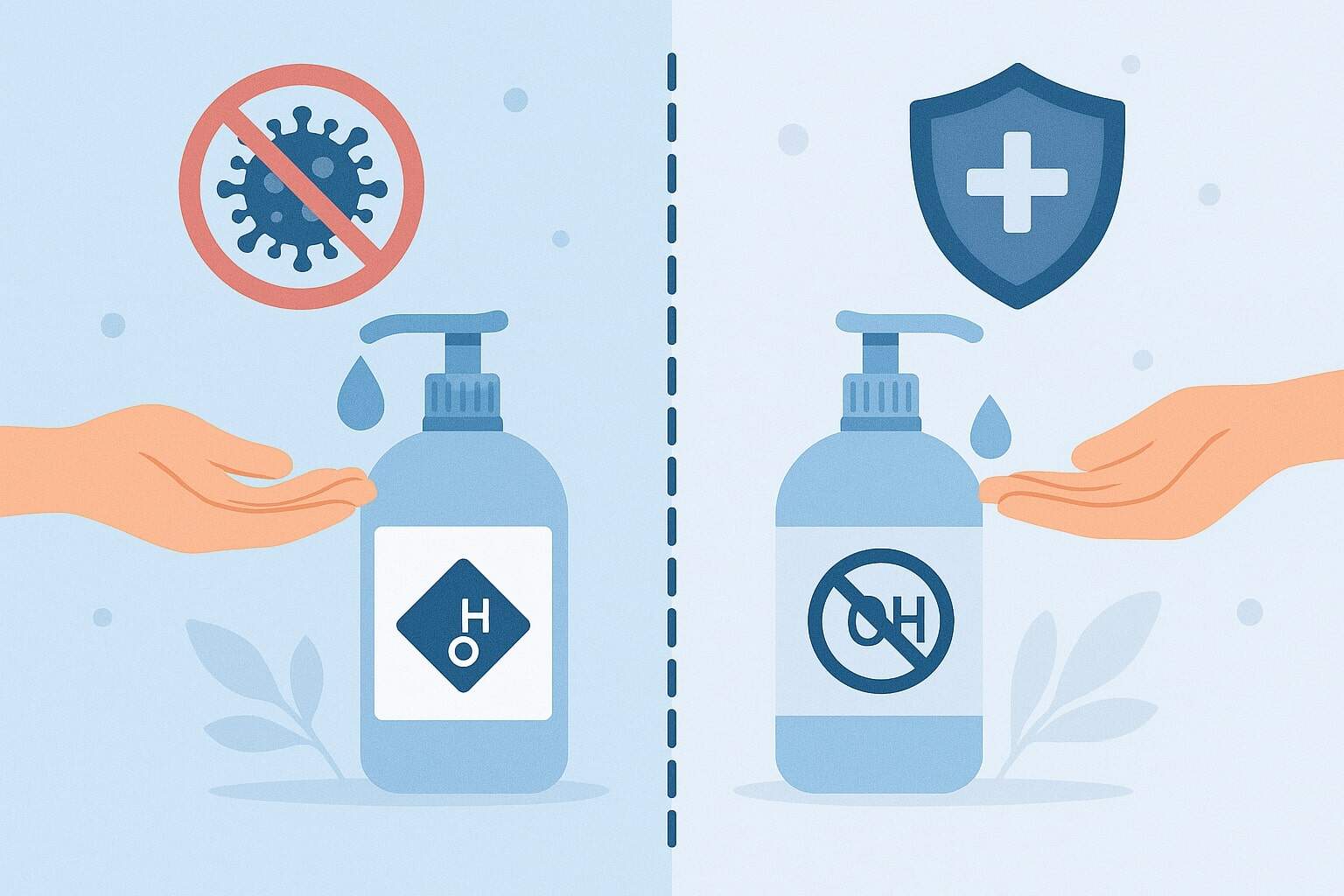
By myhandsanitizershop September 30, 2025
Hand hygiene is one of the most effective ways to prevent the spread of germs, bacteria, and viruses. Over the last two decades, particularly during outbreaks of contagious illnesses such as the flu and COVID-19, hand sanitizers have become household staples.
Today, consumers and healthcare professionals alike often ask a critical question: Which type of hand sanitizer works best—alcohol-based or alcohol-free?
This debate is more than a matter of personal preference. It touches on effectiveness, safety, usage guidelines, regulatory standards, and even environmental impact. Understanding the differences between alcohol-based and alcohol-free hand sanitizers is essential to making informed choices for your health, your family, and your workplace.
In this comprehensive guide, we will examine both types in detail—how they work, where they excel, where they fall short, and which situations they are best suited for.
Understanding Alcohol-Based Hand Sanitizers
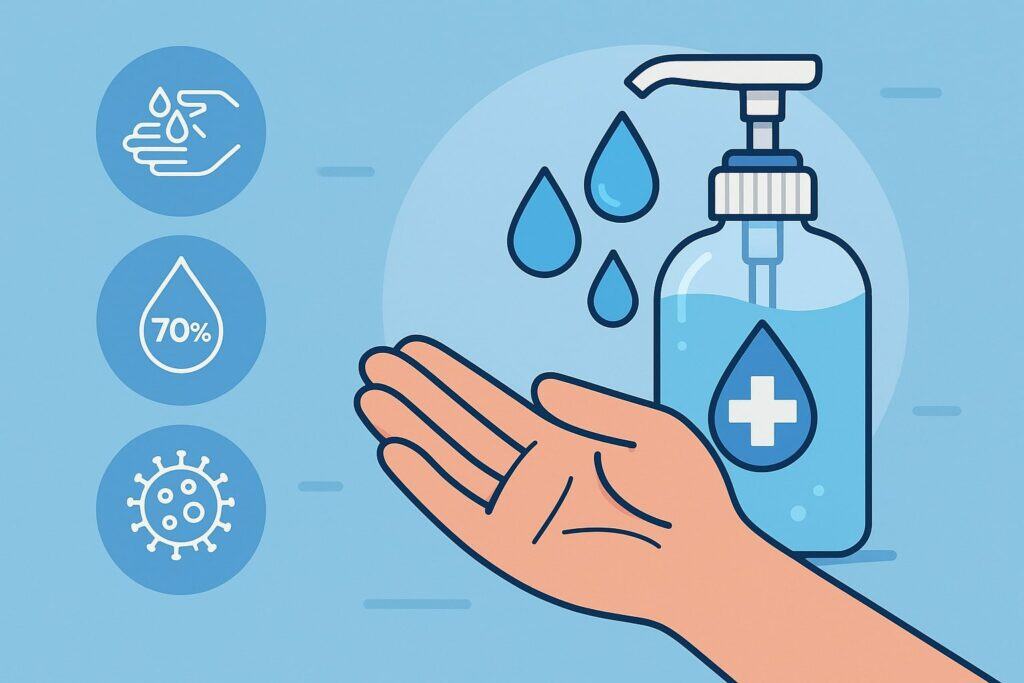
Alcohol-based hand sanitizers are the most widely recommended by health organizations worldwide, including the Centers for Disease Control and Prevention (CDC) and the World Health Organization (WHO).
They usually contain 60–95% ethanol (ethyl alcohol), isopropanol (isopropyl alcohol), or a combination of both. This concentration is not accidental—it is scientifically determined to be the most effective range for killing disease-causing germs.
How Alcohol Kills Germs
Alcohol works by denaturing proteins in microbial cells. In simpler terms, it disrupts the outer protective layers and breaks down the proteins necessary for bacteria and viruses to survive. This process leads to rapid inactivation of many types of pathogens, including:
- Enveloped viruses (such as influenza, SARS-CoV-2, and hepatitis B)
- Gram-positive and gram-negative bacteria
- Some fungi and yeasts
It acts within 15–30 seconds, making it an efficient and fast-acting option for hand hygiene, especially in environments where soap and water are unavailable.
Benefits of Alcohol-Based Sanitizers
- Broad-spectrum effectiveness: Capable of killing up to 99.9% of most germs, including many viruses.
- Rapid action: Works in seconds, requiring minimal contact time.
- Regulatory approval: Recognized and recommended by major health authorities.
- Accessibility: Available in various forms—gels, sprays, wipes—for personal and professional use.
Drawbacks and Considerations
While highly effective, alcohol-based sanitizers are not without downsides:
- Skin dryness and irritation: Alcohol can strip natural oils, leading to cracked skin with frequent use.
- Flammability: Requires proper storage away from heat sources.
- Limited effect on certain pathogens: Ineffective against bacterial spores (e.g., Clostridium difficile) and some non-enveloped viruses.
- Risk of misuse: Low-alcohol or homemade sanitizers may not be effective.
Where They Are Commonly Used
- Hospitals and clinics: Preferred for infection control.
- Public spaces: Airports, schools, and workplaces often provide alcohol-based dispensers.
- Households: Kept in personal bags, kitchens, and bathrooms for everyday hygiene.
Overall, alcohol-based sanitizers remain the global standard, but whether they are always the best choice depends on the setting and the needs of the user.
Understanding Alcohol-Free Hand Sanitizers
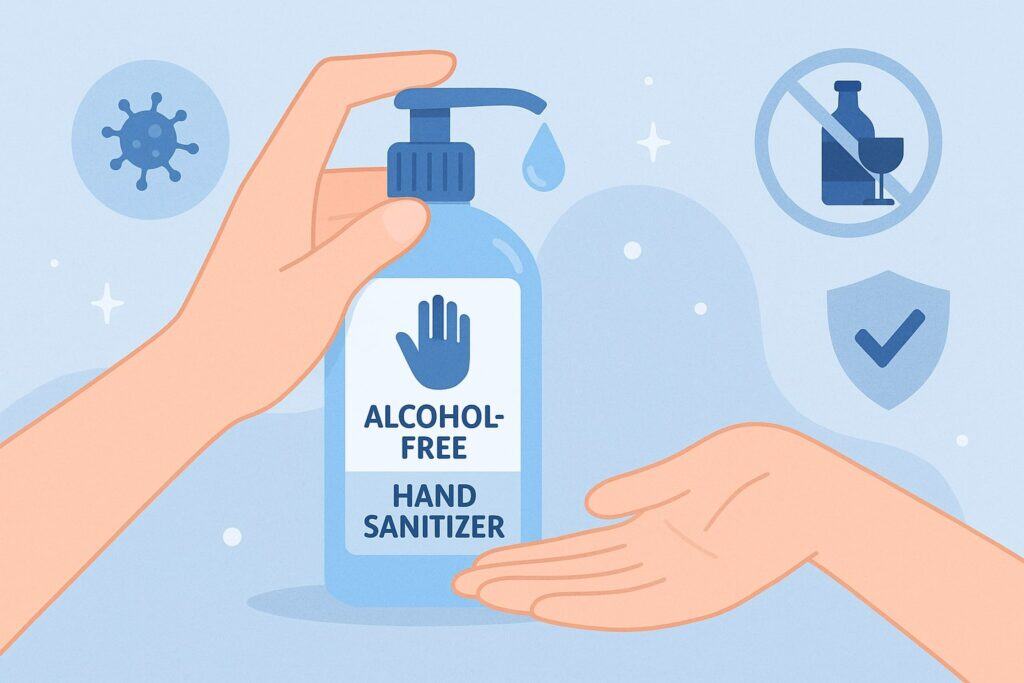
Alcohol-free hand sanitizers provide an alternative for individuals who cannot use alcohol-based products due to skin sensitivity, safety concerns, or regulatory restrictions.
These products often rely on active ingredients such as benzalkonium chloride (BZK), triclosan (less common due to regulatory scrutiny), or plant-based antimicrobials like essential oils.
How Alcohol-Free Sanitizers Work
Instead of denaturing proteins like alcohol does, alcohol-free sanitizers typically work by disrupting microbial cell membranes or preventing microbial growth.
For example, benzalkonium chloride is a quaternary ammonium compound (quat) that binds to cell membranes, causing them to leak and eventually leading to cell death.
Benefits of Alcohol-Free Sanitizers
- Gentle on skin: Less likely to cause dryness, making them ideal for frequent use.
- Non-flammable: Safer for storage in schools, childcare facilities, or industrial environments.
- Residual activity: Some alcohol-free sanitizers continue to inhibit microbial growth after application.
- Pleasant formulations: Often combined with moisturizers, fragrances, or natural extracts.
Limitations and Concerns
Despite their advantages, alcohol-free sanitizers have notable drawbacks:
- Narrower effectiveness: May not be as effective against certain viruses, particularly enveloped ones.
- Slower action: Typically take longer to inactivate pathogens compared to alcohol.
- Regulatory scrutiny: Some active ingredients like triclosan are banned or restricted due to concerns about antibiotic resistance and environmental harm.
- Consumer misconceptions: Some products marketed as “natural” may lack scientific evidence for germ-killing claims.
Where They Are Commonly Used
- Schools and childcare centers: Where safety and skin gentleness are priorities.
- Industrial and food processing settings: Where flammability risks must be minimized.
- Sensitive populations: People with eczema, dermatitis, or alcohol intolerance.
While alcohol-free sanitizers can be valuable alternatives, their effectiveness depends heavily on formulation, concentration, and proper use.
Key Differences Between Alcohol-Based and Alcohol-Free Sanitizers
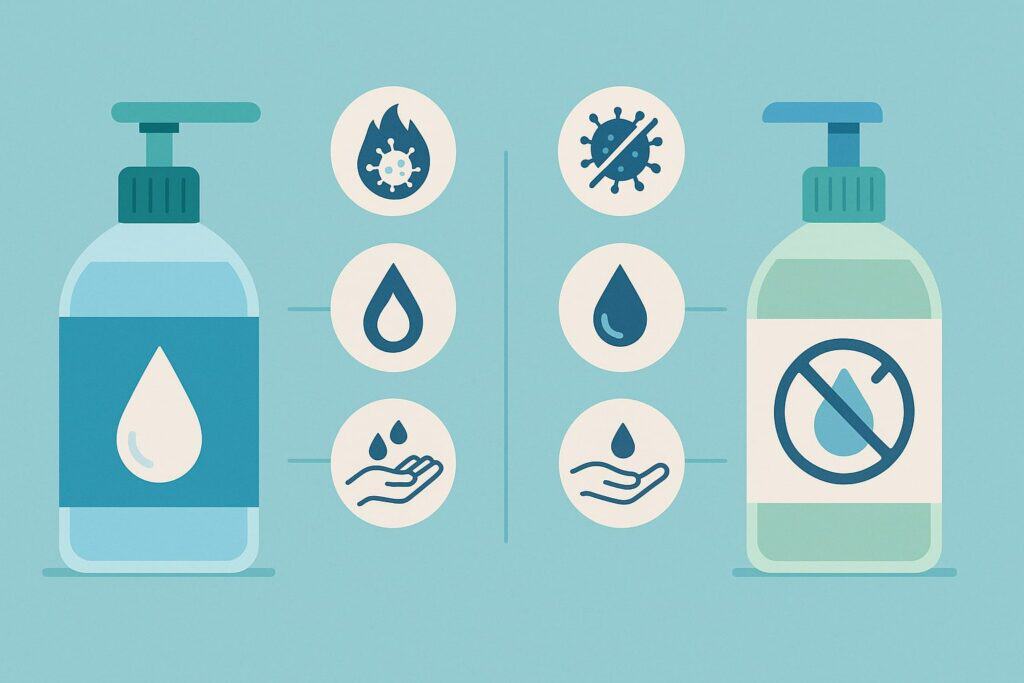
When comparing these two categories, several distinctions stand out, and understanding them helps users make informed choices.
1. Effectiveness Against Pathogens
- Alcohol-based: Kills a broad spectrum of germs quickly, including viruses and bacteria.
- Alcohol-free: Effective mainly against bacteria, with variable results against viruses.
2. Speed of Action
- Alcohol-based: Works in seconds (15–30 seconds).
- Alcohol-free: Slower, sometimes requiring up to 60 seconds or longer.
3. Residual Protection
- Alcohol-based: Effective immediately but does not provide lasting protection.
- Alcohol-free: Some formulations continue working for hours, depending on active ingredients.
4. Safety Considerations
- Alcohol-based: Flammable and potentially irritating to skin.
- Alcohol-free: Non-flammable, gentler on skin, but may raise resistance or environmental concerns.
5. Regulatory Status
- Alcohol-based: Endorsed by global health organizations.
- Alcohol-free: Accepted in some contexts, but not always recommended as a substitute.
These differences underscore that the “best” sanitizer depends on context—medical settings often prioritize speed and broad effectiveness, while schools or workplaces may value safety and skin-friendliness.
When to Use Alcohol-Based Sanitizers
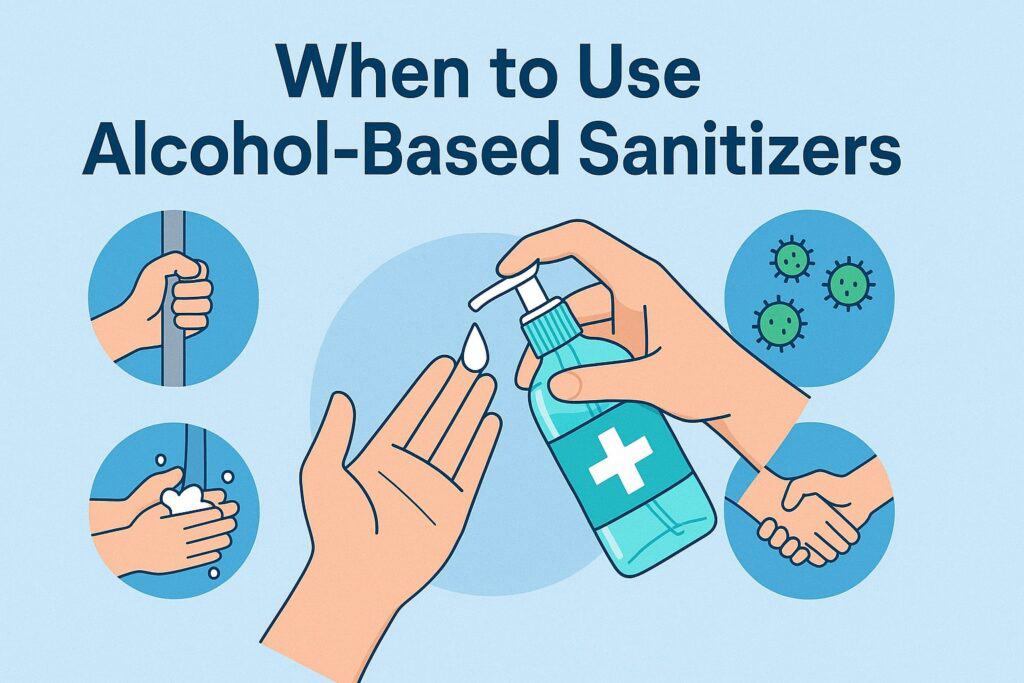
There are specific scenarios where alcohol-based sanitizers are the superior choice:
- During outbreaks of viral illnesses: Such as flu season or COVID-19 surges.
- In healthcare environments: Hospitals, clinics, and nursing homes require rapid, broad-spectrum protection.
- Travel and public exposure: Airports, public transportation, and crowded events.
- After contact with high-touch surfaces: Elevator buttons, door handles, or public restrooms.
For maximum effectiveness, it is crucial to use the sanitizer correctly: apply enough to cover all surfaces of the hands and rub until dry (about 20–30 seconds).
When to Use Alcohol-Free Sanitizers
Alcohol-free sanitizers, while not the universal standard, are well-suited for:
- Environments with children: Reduces accidental ingestion or flammability risks.
- Industries with fire hazards: Factories, aviation, and food service areas.
- Individuals with sensitive skin: People prone to dermatitis or eczema.
- Everyday personal care: When combined with moisturizing or natural ingredients.
In these situations, the trade-off in reduced effectiveness may be outweighed by safety and user comfort.
FAQs
Q1. Are alcohol-free sanitizers completely ineffective against viruses?
Answer: Not necessarily. Some alcohol-free sanitizers, particularly those formulated with benzalkonium chloride or advanced plant-derived compounds, can inactivate certain viruses. However, their spectrum is narrower compared to alcohol-based sanitizers.
For instance, while alcohol-based products are highly effective against enveloped viruses like influenza and coronaviruses, alcohol-free products may show limited success.
It is important for consumers to check product labels and certifications. Reputable brands will often provide evidence of laboratory testing against specific pathogens. Still, when facing high-risk environments such as hospitals or during a viral outbreak, alcohol-based sanitizers remain the more reliable option.
Q2. Can I use alcohol-free sanitizers if I have eczema or sensitive skin?
Answer: Yes, alcohol-free sanitizers are often preferred for people with eczema, dermatitis, or sensitive skin. Since they lack alcohol, they are less likely to dry out the skin and may even contain moisturizing agents like aloe vera or glycerin. This makes them more comfortable for frequent use without causing cracks or irritation.
That said, users should still patch-test new products. Some alcohol-free sanitizers include quaternary ammonium compounds, which may cause reactions in highly sensitive individuals. Opting for dermatologist-recommended or hypoallergenic formulations can reduce this risk significantly.
Q3. Do alcohol-based sanitizers cause antimicrobial resistance?
Answer: Unlike antibiotics, alcohol does not lead to microbial resistance in the traditional sense. Alcohol kills by physically denaturing proteins and disrupting cell membranes, which is a mechanism that bacteria and viruses cannot easily adapt to. Therefore, alcohol-based sanitizers remain effective against a broad spectrum of germs without driving resistance.
However, overuse of alcohol-free sanitizers that rely on antimicrobial agents like triclosan or quats may contribute to resistance concerns. This is why regulatory agencies have restricted certain compounds in personal care products.
Q4. Are homemade sanitizers safe and effective?
Answer: Homemade sanitizers surged in popularity during shortages, but they carry significant risks. If the alcohol concentration is too low (below 60%), the product may not effectively kill pathogens. Incorrect formulations may also cause skin irritation, separation of ingredients, or even contamination.
Health experts strongly recommend using commercially manufactured sanitizers that meet regulatory standards. If soap and water are available, washing hands for at least 20 seconds remains the gold standard.
Homemade products should only be considered as an emergency backup, with careful adherence to reputable formulas.
Q5. Which sanitizer is better for daily use?
Answer: The answer depends on your environment and personal needs. For healthcare workers or those frequently exposed to crowds and public spaces, alcohol-based sanitizers provide the most reliable protection.
For individuals with sensitive skin, children, or workplaces with flammability risks, alcohol-free options may be more practical.
Ultimately, sanitizers should be viewed as a complement to—not a replacement for—handwashing with soap and water. Daily use should balance effectiveness, comfort, and safety. Choosing the right sanitizer ensures you remain protected while maintaining healthy skin.
Conclusion
The debate between alcohol-based and alcohol-free hand sanitizers is not about declaring one universally superior. Instead, it is about recognizing that each has strengths and limitations.
- Alcohol-based sanitizers excel in healthcare, travel, and outbreak scenarios, providing rapid, broad-spectrum germ-killing power.
- Alcohol-free sanitizers offer safety, skin-friendliness, and residual activity, making them valuable for schools, sensitive populations, and environments where flammability is a concern.
The “best” sanitizer depends on context. For most people, keeping an alcohol-based sanitizer handy for public exposure and an alcohol-free option for frequent use or sensitive skin is the most balanced approach. Above all, proper usage—covering all hand surfaces and rubbing until dry—is what ensures effectiveness.
Hand hygiene remains one of the simplest yet most powerful tools in public health. By understanding the differences between alcohol-based and alcohol-free sanitizers, individuals can make smarter choices that protect themselves and others.